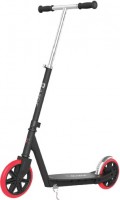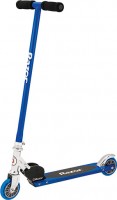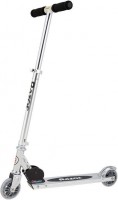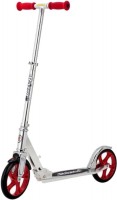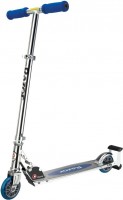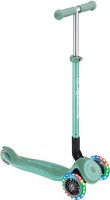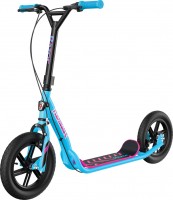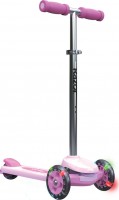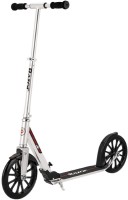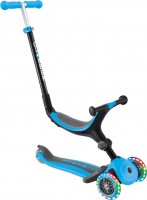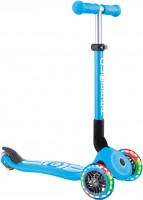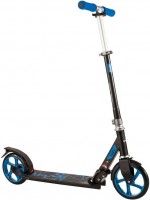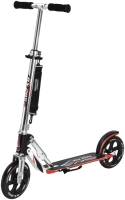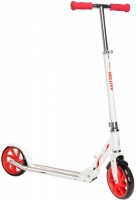Scooters Razor
All Scooters Advanced filters → |
You might be interested in
Articles, reviews, useful tips
All materials
The best electric scooters with a maximum load of 100+ kg
Electric scooters that are designed for heavy users

The best electric scooters with extended range
Electric vehicles of a new era with an autonomous range of over 40 km on a single battery charge

The best stunt scooters
Scooters with an increased margin of safety, a reliable compression system and other features

How to choose a scooter for an adult
Which scooter to choose: urban, stunt or electric and what you should pay attention to

Tips for choosing an electric scooter
Factors affecting the choice of a good scooter include the motor, battery, weight, and other features

The best lightweight electric scooters (up to 12.5 kg)
Electric scooters weighing up to 12.5 kg for comfortable use in urban environments
Scooters: specifications, types
Product type
— Scooter. Scooters of a traditional design are a deck with a handlebar mounted on wheels of a relatively small diameter. In other words, this category includes all models that do not belong to more specific varieties.
— Kickboard. A type of scooter that has two wheels in front, and the steering wheel for turning does not need to be turned, but tilted in the appropriate direction. Thanks to three points of support, kickboards are more stable than classic scooters and are well suited for initial learning to ride; in fact, most of these products are designed for a younger age.
— Stunt scooter. A variety of classic scooters designed for sports stunt riding. The main distinguishing feature of such models is increased strength: the frame is made of metal, a one-piece handlebar without adjustment and folding. Also, such scooters can be equipped with pegs and other elements for a stunt programme. However, such models cost accordingly.
— Bicycle scooter. Scooters with bicycle-type wheels: large, with spokes and inflatable tyres. This greatly increases the cross-country ability and allows you to ride even on dirt paths and other uneven terrain. Note that you should not confuse such products with pedal-less bicycles (balance bikes): in this case, we are talking about a variety of sco...oters.
— Trike. The main distinguishing feature of the trikes is the presence of two separate platforms, under each leg. There are three wheels, respectively — one in front and one on the back of each platform. Riding on such a scooter differs from the classic one in that the legs can constantly stand on the platforms. Moving forward in different models is carried out in different ways. One of the options is scooters, where you need to swing from side to side; accordingly, it will not work to drive strictly in a straight line on them — the trajectory of movement will be undulating, and wobbling. Another variety is the so-called "scissors": platforms can move and move apart, like scissor blades, which ensures forward movement.
— Snow scooter. Scooters were originally designed to move on snow. According to the device, they are similar to ordinary scooters. However, instead of each of the wheels, a small ski is installed; in addition, frost-resistant materials are used in the design. At the same time, many snow scooters allow the replacement of skis with wheels and can also be used in the warm season.
— For drifting. Scooters specially designed for driving with the active use of controlled skids. Outwardly, they are similar not so much to scooters as to electric tricycles, they have a seat and three wheels — a front (steering) and two rear ones. When driving, the rider's legs are on the steps and do not touch the ground, traction is provided by an electric motor on the front wheel, and the rear wheels are usually made swivel (as in supermarket carts) and can turn around in the course of skidding. This design allows you to easily and safely perform tricks using drift. And the most advanced and speedy models, designed for professionals, have more traditional rear wheels, without the ability to turn.
— Kickboard. A type of scooter that has two wheels in front, and the steering wheel for turning does not need to be turned, but tilted in the appropriate direction. Thanks to three points of support, kickboards are more stable than classic scooters and are well suited for initial learning to ride; in fact, most of these products are designed for a younger age.
— Stunt scooter. A variety of classic scooters designed for sports stunt riding. The main distinguishing feature of such models is increased strength: the frame is made of metal, a one-piece handlebar without adjustment and folding. Also, such scooters can be equipped with pegs and other elements for a stunt programme. However, such models cost accordingly.
— Bicycle scooter. Scooters with bicycle-type wheels: large, with spokes and inflatable tyres. This greatly increases the cross-country ability and allows you to ride even on dirt paths and other uneven terrain. Note that you should not confuse such products with pedal-less bicycles (balance bikes): in this case, we are talking about a variety of sco...oters.
— Trike. The main distinguishing feature of the trikes is the presence of two separate platforms, under each leg. There are three wheels, respectively — one in front and one on the back of each platform. Riding on such a scooter differs from the classic one in that the legs can constantly stand on the platforms. Moving forward in different models is carried out in different ways. One of the options is scooters, where you need to swing from side to side; accordingly, it will not work to drive strictly in a straight line on them — the trajectory of movement will be undulating, and wobbling. Another variety is the so-called "scissors": platforms can move and move apart, like scissor blades, which ensures forward movement.
— Snow scooter. Scooters were originally designed to move on snow. According to the device, they are similar to ordinary scooters. However, instead of each of the wheels, a small ski is installed; in addition, frost-resistant materials are used in the design. At the same time, many snow scooters allow the replacement of skis with wheels and can also be used in the warm season.
— For drifting. Scooters specially designed for driving with the active use of controlled skids. Outwardly, they are similar not so much to scooters as to electric tricycles, they have a seat and three wheels — a front (steering) and two rear ones. When driving, the rider's legs are on the steps and do not touch the ground, traction is provided by an electric motor on the front wheel, and the rear wheels are usually made swivel (as in supermarket carts) and can turn around in the course of skidding. This design allows you to easily and safely perform tricks using drift. And the most advanced and speedy models, designed for professionals, have more traditional rear wheels, without the ability to turn.
Max. load
The maximum weight of the rider that the design of the scooter can withstand without breakdowns and accidents. This point is partly determined by the age group, and mainly by the materials used in the frame (both points below). Note that manufacturers can indicate the maximum load for perfect conditions — when the scooter rides on a perfectly flat surface or even stands still. Therefore, it is worth choosing a model for this parameter with a certain margin; this is especially important for varieties designed for increased loads, in particular scooters and stunt models (see "product type"). Even more so, you should not exceed the weight indicated in the characteristics — even if the scooter does not break down immediately, this can happen at any time after, which is fraught with accidents and injuries.
Age, from
The minimum age at which a child can be entrusted with a scooter. These recommendations are quite approximate, but it is highly not recommended to deviate from them. In the case of electric scooters (see "Type"), it is worth considering that in some countries, to control such devices, you need rights obtained from a certain age; so when buying a similar model, it's ok to clarify the requirements of traffic rules.
The allowable load directly depends on the age group; according to this criterion, modern scooters can be divided into children's(permissible load up to 50 kg), teenage(from 50 to 80 kg), and adults(80 kg or more).
The allowable load directly depends on the age group; according to this criterion, modern scooters can be divided into children's(permissible load up to 50 kg), teenage(from 50 to 80 kg), and adults(80 kg or more).
Recommended height
The recommended height is the optimal rider height for which the scooter is designed. The more closely the rider's actual height matches the recommended height, the more convenient and safer it will be to use the scooter. Usually, the recommended height is indicated by a certain range of values. It is perfectly acceptable to order a scooter for height, but the difference between the actual and recommended height should be minimal. When choosing a scooter, you should be guided by other parameters, such as age group, rider weight and other characteristics.
Number of wheels
— 2 wheels. Classic design with one wheel front and rear. Found in all types of scooters except kickboards, trikes and drift models (see "Product type"). Two-wheeled scooters cannot stand upright without accessories (see "Features — Stand"), and riding them requires some balance skills, but they are considered the fastest and most agile. Note that scooters are made only two-wheeled.
— 3 wheels. By definition, all trikes and most kickboards, as well as models for drifting, are made three-wheeled (see "Product type"). However, this option can also be found in classic scooters — in the “one wheel in front and two in the back” format. In this case, the distance between the rear wheels may be different. In some models, they are widely spaced, so that the scooter can stand stably even when stationary, but its manoeuvrability is low; the narrow arrangement of the rear wheels reduces stability, but improves agility.
— 4 wheels. The design provides a pair of wheels in front and behind. It is found in classic scooters, as well as some kickboards and trikes. Four wheels provide maximum stability, but significantly reduce manoeuvrability and are not suitable for dynamic driving with sharp turns. Therefore, most four-wheeled models are designed for the smallest children who are just learning to balance.
— 3 wheels. By definition, all trikes and most kickboards, as well as models for drifting, are made three-wheeled (see "Product type"). However, this option can also be found in classic scooters — in the “one wheel in front and two in the back” format. In this case, the distance between the rear wheels may be different. In some models, they are widely spaced, so that the scooter can stand stably even when stationary, but its manoeuvrability is low; the narrow arrangement of the rear wheels reduces stability, but improves agility.
— 4 wheels. The design provides a pair of wheels in front and behind. It is found in classic scooters, as well as some kickboards and trikes. Four wheels provide maximum stability, but significantly reduce manoeuvrability and are not suitable for dynamic driving with sharp turns. Therefore, most four-wheeled models are designed for the smallest children who are just learning to balance.
Handlebar type
— T-bar. A traditional scooter handlebar in the form of a horizontal crossbar on a vertical bar. It is found in almost all types of scooters. Note that in kickboards such a steering wheel usually needs to be tilted rather than turned.
— Bike handlebar. The handlebar has a characteristic curved shape, in which the handles are bent back or moved upward relative to the middle. It is considered more convenient than the classic one, but it is more complex in design and costs more, and the difference in convenience is not so often noticeable. Therefore, this option is found much less frequently, mainly in fairly advanced models — in particular, most bicycle scooters are equipped with just such handlebars.
— Round handle. The handlebar is in the form of a ring or a pair of rings (a kind of “ears”) mounted on a vertical rod; There are also options without a top ring at all, in which the rod ends with a round knob. In any case, this design is used in models where the handlebar does not turn, but tilts from side to side — these can be either kickboards or some specific trikes (see “Type”).
— Y-bar. A handlebar with a bend in the top tube in the shape of the letter Y. Often in such handlebars, side supports are used to strengthen the structure, due to which Y-shaped handlebars are considered more durable in comparison with classic T-bars.
...— Bat-Wing. The shape of the Bat-Wing resembles Y-shaped rudders, but in the upper segment of this version, there is a special horizontal crossbar to strengthen the structure. Bat-Wing handlebars can withstand heavy loads and are installed primarily on stunt scooters.
— Bike handlebar. The handlebar has a characteristic curved shape, in which the handles are bent back or moved upward relative to the middle. It is considered more convenient than the classic one, but it is more complex in design and costs more, and the difference in convenience is not so often noticeable. Therefore, this option is found much less frequently, mainly in fairly advanced models — in particular, most bicycle scooters are equipped with just such handlebars.
— Round handle. The handlebar is in the form of a ring or a pair of rings (a kind of “ears”) mounted on a vertical rod; There are also options without a top ring at all, in which the rod ends with a round knob. In any case, this design is used in models where the handlebar does not turn, but tilts from side to side — these can be either kickboards or some specific trikes (see “Type”).
— Y-bar. A handlebar with a bend in the top tube in the shape of the letter Y. Often in such handlebars, side supports are used to strengthen the structure, due to which Y-shaped handlebars are considered more durable in comparison with classic T-bars.
...— Bat-Wing. The shape of the Bat-Wing resembles Y-shaped rudders, but in the upper segment of this version, there is a special horizontal crossbar to strengthen the structure. Bat-Wing handlebars can withstand heavy loads and are installed primarily on stunt scooters.
Handlebar material
The material of the handlebar carries almost the main information about the strength of the scooter since the rider leans on it while riding. Accordingly, this structural element in most cases is made of metal, namely:
— Aluminium. The key advantage of aluminium is its light weight. Handlebars made of aluminium are much lighter than their steel counterparts. A scooter with an aluminium handlebar can be a good choice for stunt riding. But to make an aluminium handlebar strong enough manufacturers have to increase the size and wall thickness. As a rule, aluminium handlebars have a non-standard increased tube size of 34.9 mm. Additionally, aluminium handlebars are more expensive than steel counterparts.
— Steel. The main advantage of steel is increased strength — such a handlebar can easily withstand high mechanical loads. But among the shortcomings can be noted high weight. Steel wheels have a high mass, which somewhat limits their scope, especially in terms of stunt driving.
— Aluminium. The key advantage of aluminium is its light weight. Handlebars made of aluminium are much lighter than their steel counterparts. A scooter with an aluminium handlebar can be a good choice for stunt riding. But to make an aluminium handlebar strong enough manufacturers have to increase the size and wall thickness. As a rule, aluminium handlebars have a non-standard increased tube size of 34.9 mm. Additionally, aluminium handlebars are more expensive than steel counterparts.
— Steel. The main advantage of steel is increased strength — such a handlebar can easily withstand high mechanical loads. But among the shortcomings can be noted high weight. Steel wheels have a high mass, which somewhat limits their scope, especially in terms of stunt driving.
Deck material
The weight of the scooter, its strength and resistance to stress depend on the material of the deck. In modern models, the following options can be used:
— Plastic. In scooters, this material belongs to the entry-level. The strength of plastic is low, it is not designed for heavy weight and serious loads — and, therefore, it is found mainly in models of the younger age group and the classic type (see above). On the other hand, in this category, plastic shows itself at its best: it can have almost any colour and pattern, it weighs a little, and it is inexpensive.
— Aluminium. Aluminium-based alloys combine strength, resistance to stress and low weight, due to which they are quite popular as a material among all types of scooters (see above).
— Steel. The main advantage of steel is its high strength, exceeding even aluminium, not to mention plastic. On the other hand, this material has a large weight and therefore is used less often than others, mainly in bicycle scooters (see "Type") of the older age group.
— Magnesium alloy. A fairly advanced material that combines very low weight with high strength and elasticity. At the same time, its cost is also quite high. Therefore, magnesium frames can be found mainly in expensive premium models.
— Carbon. Thi...s term usually refers to carbon fibre — carbon fibre in combination with a polymer filler. Carbon is considered a premium material: its strength is comparable to steel, and its weight is much less. However, such material is sensitive to point impacts — cracks may appear from them. However, in general, such a “trouble” requires a rather unfortunate set of circumstances. But one of the unequivocal disadvantages of carbon can be called a high cost. In addition, we note that this material is used mainly in electric scooters (see "Type") — for other varieties, for several reasons, it is easier to use more affordable materials, even if we are talking about an expensive and high-quality model.
— Plastic. In scooters, this material belongs to the entry-level. The strength of plastic is low, it is not designed for heavy weight and serious loads — and, therefore, it is found mainly in models of the younger age group and the classic type (see above). On the other hand, in this category, plastic shows itself at its best: it can have almost any colour and pattern, it weighs a little, and it is inexpensive.
— Aluminium. Aluminium-based alloys combine strength, resistance to stress and low weight, due to which they are quite popular as a material among all types of scooters (see above).
— Steel. The main advantage of steel is its high strength, exceeding even aluminium, not to mention plastic. On the other hand, this material has a large weight and therefore is used less often than others, mainly in bicycle scooters (see "Type") of the older age group.
— Magnesium alloy. A fairly advanced material that combines very low weight with high strength and elasticity. At the same time, its cost is also quite high. Therefore, magnesium frames can be found mainly in expensive premium models.
— Carbon. Thi...s term usually refers to carbon fibre — carbon fibre in combination with a polymer filler. Carbon is considered a premium material: its strength is comparable to steel, and its weight is much less. However, such material is sensitive to point impacts — cracks may appear from them. However, in general, such a “trouble” requires a rather unfortunate set of circumstances. But one of the unequivocal disadvantages of carbon can be called a high cost. In addition, we note that this material is used mainly in electric scooters (see "Type") — for other varieties, for several reasons, it is easier to use more affordable materials, even if we are talking about an expensive and high-quality model.
Clamp
Compression
Compression is a special device that connects the fork to the steering column. Thanks to the compression, the rigidity and reliability of the connection of the steering column to the fork are ensured.
— IHC. Suitable for scooters with standard diameter handlebars: 31.8mm or 1¼". This type of compression is simple in design and highly reliable. The IHC system consists of a tie bolt and an anchor. The steering wheel is connected to the compression with a clamp.
— HIC(Hidden Compression System) — this type of compression is found in scooters with a handlebar of increased diameter: 34.9 mm or 1⅜". HIC compression is widely used due to the reliability and simplicity of the design solution. The steering column is used with a kerf Steering clamp is applied to the steering column HIC compression is identical to the IHC design The only difference between the two is the rudder diameter HIC is designed for 34.9mm headsets while IHC applies to headsets 31.8 mm in diameter.
— SCS(Standart Compression System) — advanced class compression. To use the SCS, you need a scooter with a non-kerf steering column. A distinctive feature of the SCS compression is the use of a 4-bolt tie-down collar. The compression pinch bolt is screwed in from top to bottom. The steering column is put on from above. SCS compression is created under the handlebars of differen...t diameters: 34.9 or 31.8 mm. Structurally, SCS compression is similar to HIC. The key difference between these types of compression is for the most part only in the cut on the steering column. The SCS does not have a kerf, but the HIC does.
— ICS(Inverted Compression System) — simple and reliable compression. The system is represented by a coupling bolt, which is screwed in from the bottom up, through the front wheels. The anchor is usually built into the fork at the factory. But in some cases, the anchor must be hammered into the fork yourself. When working with compression, there are usually several difficulties. The first is that you need a special long key to work with fasteners. The second trick is expressed in the need to remove the front wheels every time the compression is tightened.
— Tread. Threading is the simplest method of connecting a steering column to a fork. This type of compression is typical for entry-level scooters. Scooters with threaded compression are positioned as urban models. Such scooters are not physically adapted to the impact of high mechanical loads.
Front wheel size
The diameter of the front wheel(s) of the scooter.
This parameter is selected by the manufacturer depending on the type, age category and general purpose of the scooter. If we compare similar models with different wheel diameters, then it is worth considering that the larger the wheels, the better they work on the bumps in the road, and the higher the cross-country ability. And small wheels, in turn, are great for smooth asphalt and dynamic driving, they easily accelerate and allow you to make sharp turns.
This parameter is selected by the manufacturer depending on the type, age category and general purpose of the scooter. If we compare similar models with different wheel diameters, then it is worth considering that the larger the wheels, the better they work on the bumps in the road, and the higher the cross-country ability. And small wheels, in turn, are great for smooth asphalt and dynamic driving, they easily accelerate and allow you to make sharp turns.
Rear wheel(s) size
The diameter of the rear wheel(s) of the scooter. See "Front wheel diameter" for details on the value of this parameter.
Wheel rigidity
The rigidity of the wheels supplied in the scooter
The higher the number given in this parameter, the harder materials are used in the design of the wheels and the stiffer they are. Stiff wheels easier roll on different surfaces, it is easier to accelerate on them, they allow you to more accurately feel the surface under your feet and do not wear out as quickly as soft ones; on the other hand, these wheels have less traction, are more prone to vibrations and bumps, and require extra care when cornering. Therefore, wheels with high rigidity are typical mainly for professional models, and soft options are recommended for beginner riders.
Note that most scooters allow wheel replacement; this procedure is mandatory from time to time since the wheels tend to wear out. However, if necessary, you can also change a kit that is quite suitable for riding — to a harder one, or vice versa, a softer one
— 82A. Wheels with a hardness of 82A are optimal for urban scooters. This level of stiffness provides the wheels with good strength, while the wheels tenaciously contact the rolling surface. Such scooters are poorly suited for stunt riding. — 84A. Wheels with a hardness of 84A are considered universal. These can be found both in city scooters and models for stunt riding. Rigidity at the level of 84A gives the wheels a good level of strength. Such scooters are still able to "softly" contact with the surface of the roll, but the rider will al...ready feel "hard feedback" when hitting bumps. — 85A Wheels with a hardness of 85A are more related to stunt scooters. This level of rigidity provides the wheels with a good level of strength, but due to the increased rigidity, the soft contact of the wheels with the rolling surface is lost. If the scooter does not have suspension, the stiffness of the wheels will recoil into the platform and steering rack when hitting bumps. — 86A. Wheels with a hardness of 86A are used in scooters for sports and stunt riding. Rigidity at the level of 86A is considered increased. Scooters with such wheels are usually designed for fairly high loads. Such wheels transmit impact and vibration to the scooter. Scooters without their shock absorption make riding on such hard wheels less comfortable. But at the same time, as the strength characteristics of the wheels increase, the chassis becomes more reliable and durable. — 88A. Wheels with a hardness of 88A are found in stunt scooters. They are distinguished by increased strength characteristics. Due to the high rigidity of the wheels, they can easily withstand driving on any type of rolling surface. On the other hand, riding on 88A wheels provides very strong feedback to the platform and steering column. Such wheels are recommended for scooters with a built-in shock absorption system.
The higher the number given in this parameter, the harder materials are used in the design of the wheels and the stiffer they are. Stiff wheels easier roll on different surfaces, it is easier to accelerate on them, they allow you to more accurately feel the surface under your feet and do not wear out as quickly as soft ones; on the other hand, these wheels have less traction, are more prone to vibrations and bumps, and require extra care when cornering. Therefore, wheels with high rigidity are typical mainly for professional models, and soft options are recommended for beginner riders.
Note that most scooters allow wheel replacement; this procedure is mandatory from time to time since the wheels tend to wear out. However, if necessary, you can also change a kit that is quite suitable for riding — to a harder one, or vice versa, a softer one
— 82A. Wheels with a hardness of 82A are optimal for urban scooters. This level of stiffness provides the wheels with good strength, while the wheels tenaciously contact the rolling surface. Such scooters are poorly suited for stunt riding. — 84A. Wheels with a hardness of 84A are considered universal. These can be found both in city scooters and models for stunt riding. Rigidity at the level of 84A gives the wheels a good level of strength. Such scooters are still able to "softly" contact with the surface of the roll, but the rider will al...ready feel "hard feedback" when hitting bumps. — 85A Wheels with a hardness of 85A are more related to stunt scooters. This level of rigidity provides the wheels with a good level of strength, but due to the increased rigidity, the soft contact of the wheels with the rolling surface is lost. If the scooter does not have suspension, the stiffness of the wheels will recoil into the platform and steering rack when hitting bumps. — 86A. Wheels with a hardness of 86A are used in scooters for sports and stunt riding. Rigidity at the level of 86A is considered increased. Scooters with such wheels are usually designed for fairly high loads. Such wheels transmit impact and vibration to the scooter. Scooters without their shock absorption make riding on such hard wheels less comfortable. But at the same time, as the strength characteristics of the wheels increase, the chassis becomes more reliable and durable. — 88A. Wheels with a hardness of 88A are found in stunt scooters. They are distinguished by increased strength characteristics. Due to the high rigidity of the wheels, they can easily withstand driving on any type of rolling surface. On the other hand, riding on 88A wheels provides very strong feedback to the platform and steering column. Such wheels are recommended for scooters with a built-in shock absorption system.
Wheels
— Polyurethane. Wheels with solid polyurethane tyres. This material provides good cushioning, high-quality grip and, at the same time, good rolling; it is resistant to temperature extremes and damage, durable, while it is inexpensive. Due to this, polyurethane wheels are the most popular nowadays, they can be installed even in fairly advanced models of scooters — in particular, sports ones.
— Rubber. In this case, we mean wheels with a solid rubber tyre (inflatable wheels are moved to a separate category). According to the main characteristics, rubber is similar to the polyurethane described above, and in some moments even surpasses it. So, such tyres do not make noise, smooth out the roughness of the asphalt well, have excellent grip and provide high braking efficiency. On the other hand, this material is less durable and does not tolerate temperature extremes, and therefore is used much less frequently.
— Silicone. Wheels with a solid tyre made of silicone. These tyres are quite soft; this, on the one hand, worsens the rolling compared to the same polyurethane, on the other hand, it provides excellent cushioning. At the same time, silicone is short-lived and wears out quickly, especially under high loads; therefore, wheels made of this material are quite rare and are considered suitable mainly for children's scooters.
— Plastic. Plastic has a low cost, besides, it can be given almost any colour. On the other hand, hard plastic wheels do not provide cushioning, are very noisy and generally not suitable for fast driving. Therefore, this material is found exclusively in models for kids; while the overall quality and reliability of plastic is highly dependent on the price category.
— Inflatable. The most advanced type of wheels are found in modern scooters. Wheels of this type have an inflatable tyre (as in bicycles), which provides excellent shock absorption and good grip. The disadvantages of inflatable tyres, in addition to the price, include sensitivity to punctures and increased maintenance complexity: you need to monitor the pressure and, if necessary, inflate the tyre.
— Rubber. In this case, we mean wheels with a solid rubber tyre (inflatable wheels are moved to a separate category). According to the main characteristics, rubber is similar to the polyurethane described above, and in some moments even surpasses it. So, such tyres do not make noise, smooth out the roughness of the asphalt well, have excellent grip and provide high braking efficiency. On the other hand, this material is less durable and does not tolerate temperature extremes, and therefore is used much less frequently.
— Silicone. Wheels with a solid tyre made of silicone. These tyres are quite soft; this, on the one hand, worsens the rolling compared to the same polyurethane, on the other hand, it provides excellent cushioning. At the same time, silicone is short-lived and wears out quickly, especially under high loads; therefore, wheels made of this material are quite rare and are considered suitable mainly for children's scooters.
— Plastic. Plastic has a low cost, besides, it can be given almost any colour. On the other hand, hard plastic wheels do not provide cushioning, are very noisy and generally not suitable for fast driving. Therefore, this material is found exclusively in models for kids; while the overall quality and reliability of plastic is highly dependent on the price category.
— Inflatable. The most advanced type of wheels are found in modern scooters. Wheels of this type have an inflatable tyre (as in bicycles), which provides excellent shock absorption and good grip. The disadvantages of inflatable tyres, in addition to the price, include sensitivity to punctures and increased maintenance complexity: you need to monitor the pressure and, if necessary, inflate the tyre.
Bearing
Bearings that the scooter is equipped with. This paragraph usually indicates not the model/brand, but the class of bearings according to the ABEC standard. Standard options for modern scooters are ABEC 5, ABEC 7, and ABEC 9 ; the higher the number, the higher the quality and accuracy of the part.
There is an opinion that better bearings allow you to accelerate better and go faster. This is partly true, but acceleration and speed are highly dependent on a number of other points — the size and material of the wheels, the weight of the scooter, etc. So models with bearings of the same class can differ markedly in speed characteristics. But what this indicator unambiguously affects is durability and price: high accuracy affects the cost, but such bearings last longer and carry loads better.
Also note that for relatively simple use, ABEC 5 class bearings are quite enough. It makes sense to specifically look for a model with ABEC 7 or ABEC 9 only if you need a scooter for advanced stunts or professional high-speed riding. However, if the selected model has high-quality bearings, it will not be worse from them anyway.
There is an opinion that better bearings allow you to accelerate better and go faster. This is partly true, but acceleration and speed are highly dependent on a number of other points — the size and material of the wheels, the weight of the scooter, etc. So models with bearings of the same class can differ markedly in speed characteristics. But what this indicator unambiguously affects is durability and price: high accuracy affects the cost, but such bearings last longer and carry loads better.
Also note that for relatively simple use, ABEC 5 class bearings are quite enough. It makes sense to specifically look for a model with ABEC 7 or ABEC 9 only if you need a scooter for advanced stunts or professional high-speed riding. However, if the selected model has high-quality bearings, it will not be worse from them anyway.
Front brake
— Rim. The rim brake is considered the simplest type of braking system. Such brakes provide a smooth deceleration and a complete stop of the scooter at an average speed. The stopping distance is usually medium or long. The rim brake is characterised by pads, which, using a special mechanism, are pressed against the wheel rim. The pads themselves are driven by a lever which is placed on the handlebar. Among the advantages of a rim brake are low price and simple design. And drawbacks are fairly quick wear of the pads and the need to adjust the brakes as the friction linings wear out. Additionally, when using a scooter with a rim brake, be aware that the pads become less grippy if the rim is wet. In rainy, cloudy and slushy weather, the rim brake cannot be relied upon.
— Disk. Disc type brakes are considered more advanced than rim (shoe) systems. The disc brake allows the scooter to stop quickly enough, and the braking distance itself can be either minimal or medium. Such brakes are represented by a friction clutch that acts on a small-diameter disc. The disc is attached to the wheel axle. The clutch is pressed against the brake disc with a sufficiently large force, which allows the disc brakes to be effective even when wet on the clutch. The disc brake is controlled by a lever that is placed on the steering wheel. The advantages of a disc brake for a scooter are reliability, durability and the ability to stop quickly. Among the shortcomings, we highlight the high...price and the need to adjust as the friction clutch wears out.
— Drum. Drum brakes slow down well and provide a fairly quick stop. In terms of efficiency, the drum brake for a scooter is between the rim and disc brake systems. The drum brake uses pads that are located inside the rim. In this case, the friction plates act on the inside of the rim. The brake with a drum device has many advantages: a large friction clutch contact surface, water protection, reliability and durability. Among the shortcomings can be noted the use of massive wheels, the complexity of service maintenance, and the need for periodic adjustment.
— Electric. Electric brakes are used by electric scooters. In this case, the deceleration and stop are made by the electric motor itself, by reducing the speed. Usually, the electric brake provides a soft and smooth stop. Usually, the electric brake acts as an auxiliary brake system. Also, advanced scooters often use a regenerative electric brake. In this case, when decelerating, energy is recovered, which allows you to recharge the battery pack.
— No brake. The front wheel is not equipped with a brake system. The brake can only be provided at the rear. But there are also such scooters that have no brakes either in front or in the back. The complete absence of a traditional brake is typical for the simplest scooters. Slowing down and stopping occur due to the actions of the rider himself. In this case, the user brakes with a foot extended to the ground or due to the natural deceleration of the roll. Usually, scooters without a brake are not physically capable of reaching dangerously high speeds.
Rear brake
— No brake. The rear wheel is not equipped with a brake. In this case, the braking system may be provided at the front. However, some scooters do not have brakes both at the rear and at the front. The advantage of scooters without a rear brake is that the vehicle will not skid to the side when braking actively when cornering. Scooters without brakes, both front and rear, are mostly the simplest children's models that do not accelerate to a dangerous speed. In this case, braking occurs either by reducing the overrun or by kicking the ground.
— Rim. Rim brakes slow and stop the scooter by pressing the pads against the wheel rim. The rim brake system has an average efficiency. Usually, the scooter stops gently and smoothly. The rim brake is most often installed on the rear wheel of the scooter. The soft brake prevents the vehicle from skidding when braking on turns. Rim brakes are good because they have a simple design. This kind of braking system is easy to maintain. The weak point of rim brakes is a sharp decrease in efficiency when moisture enters the rim.
— Disk. The disc brake on the rear wheel ensures a quick stop of the scooter. This type of braking system is designed more for sports and stunt scooters that often need to quickly decelerate at high speed. But the disc brake can also be found in pleasure, as well as city boards. Disc brakes have a short-stroke friction clutch. Due to the small distance between the pads and the disc, the friction...clutch very quickly comes into contact with the working surface of the brake disc. In this case, the friction clutch is pressed against the disk with a sufficiently large force. The disc brake allows the scooter to stop extremely efficiently. But when using a disc brake on the rear wheel, you should be careful, because when braking hard, especially when cornering, the scooter can skid to the side.
— Drum. The drum brake has above-average efficiency. The drum brake makes the rear wheel massive and heavy. For this reason, scooters with a drum brake system are rarely used as a stunt and sport scooters, but there are exceptions. Urban models are often equipped with a drum-type brake. This type of brake has a closed design. The pads are inside the wheel. Friction linings rub against the inner surface of the rim. Access to the drum brake is closed by a protective cover. Thanks to the closed design, neither moisture nor other blockages get inside the brake drum, which makes the brake operation more reliable and trouble-free. Among the shortcomings can be noted an increase in the dimensions and weight of the wheel and the complexity of maintenance.
— Electric Electric brake is used on electric scooters. The brake system of this type makes the stop extremely soft, slowing down occurs when the speed of the electric motor decreases. The rear location of the electric brake assumes that the electric motor is mounted on the rear wheel. The presence of an electric motor makes the wheel massive, it is difficult to use such scooters for stunts or sports riding, although the engine allows you to quickly pick up and hold speed for a long time. The electric brake system is highly reliable and durable, it does not require maintenance. But if the battery pack on the scooter runs out, the electric brake will not work. For such cases, an additional mechanical (hand or foot) brake is usually provided.
Features
- Foldable. The ability to fold the scooter — usually by "laying" the handlebar in a horizontal position, on the deck; in some models, the grips of the handlebar are also foldable. This feature greatly simplifies storage and transportation outside business hours. True, folding models are somewhat more expensive and slightly less reliable than clumsy ones, but in many cases, these moments are not critical.
- Handlebar height adjustment. The ability to change the height of the handlebar, adjusting it to the height of the user. This feature will be especially useful if the scooter is bought for a child for several years: children grow quickly, and every season a higher handlebar height is required. See "Maximum height" for details on height adjustment.
- Suspension. The scooter has a suspension system — most often on the front wheel. However, there are models with full suspension. In any case, such a system makes the ride more comfortable and smoothes out vibrations, but reduces rolling and control accuracy. Therefore, for example, sports scooters and snow scooters (see "Type") do not have this feature, and it is extremely rare in kickboards.
- Stand. A device that allows you to put the scooter in a vertical position on any suitable surface without using additional supports — such as walls, benches, fences, et...c. It is usually carried out in the form of a folding plate or a curly frame under the deck: in the folded state it is raised and does not interfere with movement, and if it is lowered, the scooter acquires an additional point of support.
- Seat. Own seat, allowing you to ride a scooter while sitting. Most often, this function is found in kickboards (see "Type") for the smallest children who are still unable to confidently keep their balance — the seat in such models also serves as fall protection. In addition, by definition, drift models are equipped with a seat.
— Basket on the handlebar. The basket mounted on the handlebars acts as a luggage compartment and can be used to carry various items, such as your favourite toys or a change of clothes. The capacity of the baskets is usually small, but they can provide some convenience. This function occurs mainly in models of the younger age group.
- Bottle holder. A device that provides for the installation of exclusively drinking bottles. This is facilitated by a cylindrical shape, in which such a container will ideally fit, while it will not fall out during the ride. This decision is applicable not so much to children's scooters as to adults, when the scooter is used not for entertainment, but for movement and thirst can overtake at any moment.
- Glowing wheels/deck. The scooter has wheel and/or deck illumination. Glowing wheels are usually made of a transparent polymer with LEDs embedded in them; the deck can be illuminated both on the sides and below. In any case, this function not only provides an original appearance but also makes the scooter more visible, which has a positive effect on safety — especially at dusk and in the dark. The backlight can be powered both by batteries and by a built-in generator that generates energy when the wheels rotate.
- Flashlight / headlight. The presence of a flashlight or headlight in the scooter. This function will be useful, especially in twilight and darkness: it provides illumination of the road and also makes the scooter more visible to other road users.
— Signal/bell. The presence of a bell or other sound signal (for example, a horn) in the kit. Such a device is useful for warning others about the movement of the scooter, it allows you to avoid unpleasant incidents.
- Pegs. Devices on the wheels of sports scooters that allow you to perform various trick exercises, namely, to slide along curbs, railings, etc. It is an additional stop that is installed in the wheel axle of the scooter and can be used not only as a fulcrum for the foot but also as a support when driving over various obstacles (railings, ramps, etc.). As a rule, scooters for stunt/sports riding are equipped with pegs. At the same time, they can be equipped with both the front and rear wheels and in some cases, the peg is installed on both the right and left sides of the wheel.
- Parent handle. A long handle is mounted on some kickboards so that an adult can comfortably hold on to it while standing next to it. Thus, the parent can, to a certain extent, control the movement of the child, stop him at the right time or vice versa, push, or even carry the baby, like in a stroller. Such a solution is relevant for models with a seat and for children who are not yet capable of independent movement on a scooter.
- Handlebar height adjustment. The ability to change the height of the handlebar, adjusting it to the height of the user. This feature will be especially useful if the scooter is bought for a child for several years: children grow quickly, and every season a higher handlebar height is required. See "Maximum height" for details on height adjustment.
- Suspension. The scooter has a suspension system — most often on the front wheel. However, there are models with full suspension. In any case, such a system makes the ride more comfortable and smoothes out vibrations, but reduces rolling and control accuracy. Therefore, for example, sports scooters and snow scooters (see "Type") do not have this feature, and it is extremely rare in kickboards.
- Stand. A device that allows you to put the scooter in a vertical position on any suitable surface without using additional supports — such as walls, benches, fences, et...c. It is usually carried out in the form of a folding plate or a curly frame under the deck: in the folded state it is raised and does not interfere with movement, and if it is lowered, the scooter acquires an additional point of support.
- Seat. Own seat, allowing you to ride a scooter while sitting. Most often, this function is found in kickboards (see "Type") for the smallest children who are still unable to confidently keep their balance — the seat in such models also serves as fall protection. In addition, by definition, drift models are equipped with a seat.
— Basket on the handlebar. The basket mounted on the handlebars acts as a luggage compartment and can be used to carry various items, such as your favourite toys or a change of clothes. The capacity of the baskets is usually small, but they can provide some convenience. This function occurs mainly in models of the younger age group.
- Bottle holder. A device that provides for the installation of exclusively drinking bottles. This is facilitated by a cylindrical shape, in which such a container will ideally fit, while it will not fall out during the ride. This decision is applicable not so much to children's scooters as to adults, when the scooter is used not for entertainment, but for movement and thirst can overtake at any moment.
- Glowing wheels/deck. The scooter has wheel and/or deck illumination. Glowing wheels are usually made of a transparent polymer with LEDs embedded in them; the deck can be illuminated both on the sides and below. In any case, this function not only provides an original appearance but also makes the scooter more visible, which has a positive effect on safety — especially at dusk and in the dark. The backlight can be powered both by batteries and by a built-in generator that generates energy when the wheels rotate.
- Flashlight / headlight. The presence of a flashlight or headlight in the scooter. This function will be useful, especially in twilight and darkness: it provides illumination of the road and also makes the scooter more visible to other road users.
— Signal/bell. The presence of a bell or other sound signal (for example, a horn) in the kit. Such a device is useful for warning others about the movement of the scooter, it allows you to avoid unpleasant incidents.
- Pegs. Devices on the wheels of sports scooters that allow you to perform various trick exercises, namely, to slide along curbs, railings, etc. It is an additional stop that is installed in the wheel axle of the scooter and can be used not only as a fulcrum for the foot but also as a support when driving over various obstacles (railings, ramps, etc.). As a rule, scooters for stunt/sports riding are equipped with pegs. At the same time, they can be equipped with both the front and rear wheels and in some cases, the peg is installed on both the right and left sides of the wheel.
- Parent handle. A long handle is mounted on some kickboards so that an adult can comfortably hold on to it while standing next to it. Thus, the parent can, to a certain extent, control the movement of the child, stop him at the right time or vice versa, push, or even carry the baby, like in a stroller. Such a solution is relevant for models with a seat and for children who are not yet capable of independent movement on a scooter.
Max. height
The maximum height to which the height-adjustable handlebar can be set (or just the height of the handlebar in the working position, if height adjustment is not provided).
The height of the handlebars should be such that the rider can stand on the deck straight, without bending his back, and hold on to the handles with slightly bent arms. At the same time, there is no unambiguous relationship between this parameter and the height of the rider. So the perfect option to determine the optimal height is to try it yourself, and then choose a scooter based on the result.
The height of the handlebars should be such that the rider can stand on the deck straight, without bending his back, and hold on to the handles with slightly bent arms. At the same time, there is no unambiguous relationship between this parameter and the height of the rider. So the perfect option to determine the optimal height is to try it yourself, and then choose a scooter based on the result.
Deck size
Scooter deck size. This item can indicate both the length and width or only one size — most often this is the length.
In general, this parameter is secondary: manufacturers choose the size of the deck depending on the type, age category, general specialization and other features of the scooter. Legroom, usually, is guaranteed to be enough on the deck. We only note that shorter decks are more agile, and longer ones are stable on the course.
In general, this parameter is secondary: manufacturers choose the size of the deck depending on the type, age category, general specialization and other features of the scooter. Legroom, usually, is guaranteed to be enough on the deck. We only note that shorter decks are more agile, and longer ones are stable on the course.
Footspace
This term refers to the useful area of the deck on which you can put your foot. It is size without taking into account the folding mechanism, wheel fastening and other elements that are not intended for the leg.
Clearance
Clearance is the distance from the road to the platform. The greater the clearance, the more free space between the road and the base of the scooter. With an increase in clearance, it becomes possible to ride on inclined surfaces, that is, descents and ascents. With low ground clearance, the platform will rub against the road if you drive on inclined surfaces. Scooters with high clearance open up great features for the rider in the field of stunt and sports riding. The clearance is affected by both the diameter of the wheels and the height of the wheel mounts.
Weight
The total weight of the scooter; for electric models it is the total operating weight is indicated, with batteries installed.
This option has two meanings. Thus, lighter scooters accelerate and manoeuvre better and require less effort from the user. In turn, more massive models maintain speed longer and are more stable on the course. In addition, note that less weight, other things being equal, means either less strength or more cost.
The lightest modern scooters weigh less than 2 kg — these are mostly relatively inexpensive classic models and kickboards (see "Type"). Sports models already have a weight of 2.5 kg, and often more. The most massive among non-self-propelled models are scooters — from 5 kg. And electric scooters inevitably turn out to be heavy due to motors and batteries, their mass can reach 10 kg or even more.
This option has two meanings. Thus, lighter scooters accelerate and manoeuvre better and require less effort from the user. In turn, more massive models maintain speed longer and are more stable on the course. In addition, note that less weight, other things being equal, means either less strength or more cost.
The lightest modern scooters weigh less than 2 kg — these are mostly relatively inexpensive classic models and kickboards (see "Type"). Sports models already have a weight of 2.5 kg, and often more. The most massive among non-self-propelled models are scooters — from 5 kg. And electric scooters inevitably turn out to be heavy due to motors and batteries, their mass can reach 10 kg or even more.

